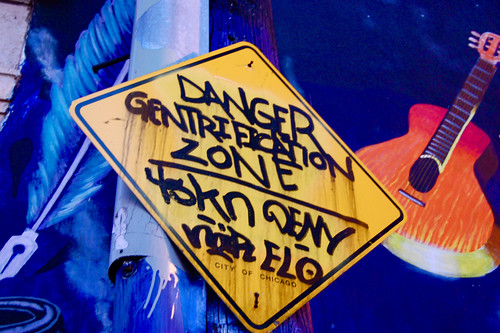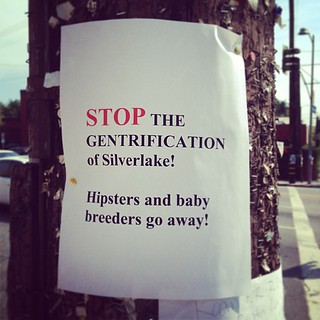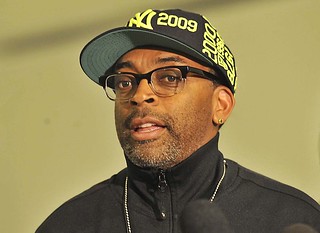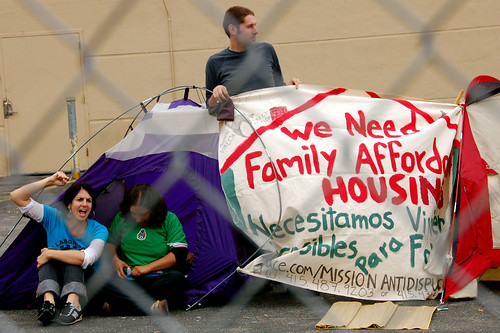The Thorny Matter of Gentrification
A few days ago, I made a presentation to a group of thoughtful and accomplished philanthropists on sustainable land development. I made a strong pitch for urban revitalization and was countered with a question about gentrification, the messy phenomenon that occurs if longtime residents of older neighborhoods find themselves priced out of their own communities as those neighborhoods become more sought-after and valuable. To be honest, I don't think I handled the question particularly well.
I never do, really, even though it comes up a lot. The issue is just too thorny on all sides and, in most cases, racially charged, because minority populations are the ones who feel squeezed when more affluent, generally white, residents rediscover cities and move in. I have a lot of sympathy for long-timers who fear losing control of their neighborhoods and, in too many cases, their very homes as rents and property taxes go up with increased value brought on my increased demand. But, on the other hand, the environmental, fiscal and, yes, social benefits of revitalization and repopulation of our older, frequently distressed neighborhoods are so substantial that I believe strongly that they must continue.
Surely we haven't reached the point where making inner-city neighborhoods more attractive to more residents is a bad thing. And does anyone really have a right in the US to keep newcomers out? Didn't we have a civil rights movement largely over that very issue?
I get it that we want the rebirth of America's long-forgotten neighborhoods to lift all boats, not just provide a haven for affluent new residents. But I find myself stymied when trying to find a balanced solution, since the argument of anti-gentrification forces can all too easily amount to, "I don't want the neighborhood to improve so much that properties in it become worth much more." No one would say it in those words, of course. Is there a way to provide some protection to longstanding residents without providing so much that it inhibits the very improvement that so many of our neighborhoods badly need?
The paralysis of imperfect choices
The good news is that a number of thoughtful people have been thinking and writing about these things. Writing last year in Rooflines, the excellent blog of the National Housing Institute, Rick Jacobus eloquently described how gentrification can too easily feel like a problem with no solution at all:
"The way most people talk and think about [gentrification] seems to create a black hole of self-doubt from which no realistic strategy for neighborhood improvement can escape.
"The paralyzing thinking goes like this: We want to improve lower-income neighborhoods to make them better places for the people who live there now but anything we do to make them better
places will inevitably make people with more money want to live there and this will inevitably drive up rents and prices and displace the current residents, harming the people we set out to help (or, in many cases, harming the very people responsible for making the neighborhood better through years of hard work) and rewarding people who drop in at the last minute to displace them.
"Once you recognize this dynamic, it is very hard to talk yourself into wholeheartedly backing any kind of action. It seems wrong to leave distressed communities to rot but it also seems wrong to turn them around. Sadly, the most common response is to try to find strategies that improve things, but not too much."
One of my favorite recent articles on the subject was written last month by Scott Doyon for his planning firm's blog, PlaceShakers. Scott, who has become a friend through an online community of urbanists who check in with each other almost daily, might be described by some as an early-generation gentrifier: he and his wife bought into a working-class, African American neighborhood some twenty years ago because it was affordable. At the time, they had good education but almost no money. Since then, he's seen the neighborhood attract more and more white, increasingly affluent residents.
Thoughtful and not-so-thoughtful reflections
But Scott also points out that the neighborhood had been predominantly white before it became predominantly black. He sees the problem as one driven by cultural conflicts as much as by fear of economic displacement:
"Today's everyday in-town neighborhood newcomers are more affluent than ever before and affluent people who pay premium prices don't necessarily want to contend with things outside the comfort of their own reality. Which means they often come across as culturally tone deaf and insistent upon remaking a neighborhood to serve only the narrow spectrum of their own needs and desires.
"If you read a lot about gentrification, or discuss it with those directly impacted, you'll frequently find these types of behaviors described as exemplifying a sense of entitlement: Cultural overhaul with no regard for place, people or history.
"It's not an unfounded characterization. But it's only half the reason why gentrification is such a messy and divisive issue. The other half is the all-too-prevalent premise that newcomers simply aren't a part of the neighborhood. That their presence is that of unwelcome guest rather than neighbor. That, despite being a resident, they just haven't earned it."
I get reports on one of DC's gentrification war zones on roughly a weekly basis from my work colleague G, who is a lot like Scott economically and culturally, and who lives in a transitioning neighborhood. G and his family have made a lot of friends, both longtime residents and newer ones, black and white, in his mixed-race, mixed-income community. Most of them get along quite well. But one of the things that particularly frustrates him is the knee-jerk opposition that one of his more vociferous neighbors expresses to almost any new small business in the neighborhood likely to attract white patrons.
I suspect it's the cultural fear that drives G's NIMBY neighbor more than it is opposition to, say, any particular proposed pizza joint. I'm not unsympathetic. But, my goodness, that's the same fear that drives the anti-immigration crazies, and that used to (and, regrettably, still does in some places) drive longtime white residents who feared African-American migration into "their" neighborhoods. Is it really just human nature that we're up against here?
Scott's article closes with a plea for community:
"If your neighborhood is divvied up as old vs. new, or rich vs. poor, or white collar vs. blue collar, or black vs. white, or any number of ways people succumb to their most divisive and least appealing tendencies, and your actions serve to reinforce those distinctions rather than overcome them then, well, good luck with that.
"Managing change, directing it, channeling it, or even mitigating it is no small endeavor. But neighborhoods in transition have the opportunity to try. To commit themselves to pursuing reality-based strategies that respectfully unite people, leverage their talents and resources, mitigate conflicts, and prevent what's ultimately the worst possible outcome at either end of the spectrum: monoculture.
"But it only works if everyone — of every status — works together. Wherever you sit in the equation, us vs. them simply ain't gonna cut it."
Spike Lee's rant
It will surprise few readers that, when filmmaker and perennial cultural antagonist Spike Lee went off on the subject of gentrification recently, he didn't bother with such niceties. At a lecture in Brooklyn for Black History Month, an audience member attempted to ask Lee a question about gentrification. The would-be questioner didn't get very far.
Lee got worked up, real fast. He went straight for the cultural jugular, scoring some fair points but . . .
"Then comes the motherfuckin' Christopher Columbus Syndrome. You can't discover this! We been here.
You just can't come and bogart. There were brothers playing motherfuckin' African drums in Mount Morris Park for 40 years and now they can't do it anymore because the new inhabitants said the drums are loud . . .
"Nah. You can't do that. You can't just come in the neighborhood and start bogarting and say, like you're motherfuckin' Columbus and kill off the Native Americans. Or what they do in Brazil, what they did to the indigenous people. You have to come with respect. There's a code. There's people . . .
"I mean, [whites] just move in the neighborhood. You just can't come in the neighborhood. I'm for democracy and letting everybody live but you gotta have some respect. You can't just come in when people have a culture that's been laid down for generations and you come in and now shit gotta change because you're here? Get the fuck outta here. Can't do that!"
It's not clear from the transcript, but apparently the guy in the audience was trying to make a point about improved schools, city services and rising property values, sort of an "isn't there a good side to gentrification?" argument. Heh. Lee continued:
"Whoa whoa whoa. And then! So you're talking about the people's property change? But what about the people who are renting? They can't afford it anymore! You can't afford it. People want live in Fort Greene. People wanna live in Clinton Hill. The Lower East Side, they move to Williamsburg, they can't even afford fuckin', motherfuckin' Williamsburg now because of motherfuckin' hipsters . . .
"So, look, you might say, Well, there's more police protection. The public schools are better. Why are the public schools better? . . . Why did it take this great influx of white people to get the schools better? Why's there more police protection in Bed Stuy and Harlem now? Why's the garbage getting picked up more regularly? We been here!"
Understatement isn't Lee's strong point. That said, I understand his bitterness that people suffered during periods of neglect. However, surely that shouldn't mean that improvement in neighborhoods shouldn't occur now if white people are among the advocates for it? Things can indeed feel pretty hopeless if that's where the rhetoric takes you.
Can policy help?
I honestly don't have an answer to the cultural issues. No policy is going to make the Spike Lees of the world less angry about past slights, or newcomers who seek a quiet home more tolerant of noise. But maybe, just maybe, there are some reasonable approaches to protect lower-income, longtime residents against unreasonable rent or tax hikes caused by rising property values in once-distressed neighborhoods. That would be a start.
Philadelphia, for example, has adopted a program that allows homeowners who have lived in homes for ten years or more and whose household income is less than about $110,000 annually to cap and freeze their assessments for ten years if the assessments increased by 300 percent or more as part of the city's new property tax formula. A 300 percent increase sounds like a high bar, but it is not uncommon in Philadelphia, suggests an article written by Timothy Williams for the New York Times.
In Boston, Williams reports, the City Council has approved a bill allowing residents who have owned homes for more than ten years and whose property taxes have increased by ten percent or more to defer property tax payments until they sell their home. That makes a lot of sense to me. (The bill was pending approval by the state legislature as of earlier this month.)
Those policies wouldn't help renters. But a conceptual proposal reported by Miriam Axel-Lute earlier this year in Rooflines would. The idea is that, when rents increase by more than a certain amount in a given neighborhood, longtime renters would be "given vouchers for a certain number of years that cover the price difference, enabling them to stay in place (or move somewhere else if they want) or a low-cost, minimal down payment loan to purchase their home." While Axel-Lute concedes that the proposal is conceptually loose (it was reportedly authored by Rachel Godsil In a newsletter of the Poverty & Race Research Action Council), and there is no indication of how such a program would be paid for, it struck me as at least worth passing along as a thought-starter.
Alan Mallach, a senior fellow at the National Housing Institute who also contributes regularly to Rooflines, separates the problems commonly associated with gentrification into three parts:
"First, what happens to the individuals and families who live in the area when house prices start to go up? And second, what happens to the neighborhood's housing stock, and ultimately its social mix? A third question, which seems to preoccupy some people more than the first two, is what happens to what one might call the 'social ownership' of the neighborhood. Each question needs to be addressed separately."
As for the first question, Mallach believes strongly that families "should be protected from the impacts of rapid or steep housing cost increases." With regard to homeowners, he cites the Philadelphia approach (and a program in Cook County, Illinois) with approval. He has this to say about renters:
"Tenants can be protected through different means, including carefully targeted rent control, requiring landlords to provide relocation assistance, enforcing laws barring landlord harassment, incentives to landlords to maintain affordable rents, and programs like Washington DC's Tenant Right of First Refusal, which gives tenants the right to buy their building if the owner puts it on the market."
He considers the second question more important, though, insofar as it suggests that gentrification will cause a diminution of affordable housing. But Mallach believes the answer may lie in the complex arena of affordable housing policy generally, and that the extent to which additional affordable housing needs to be included in any one neighborhood "would depend on the existing amount of permanent or long-term affordable housing in the neighborhood, the availability of affordable housing in other parts of the city and region, and the market price of housing in the city and region." He cites inclusionary zoning among the tools that can be employed.
Change is inevitable
Mallach warns against giving much weight to the "social ownership" question, which I believe underlies the most passionate complaints of Spike Lee and my colleague's NIMBY neighbor:
"I am deeply skeptical about 'social ownership' of any neighborhood by any racial, ethnic, social, or economic group. Neighborhoods in the United States are constantly changing, and the group (however defined) that lives in an area today is likely to have displaced some other group, which displaced a yet earlier group, and so forth as long as the neighborhood has been around. The specter of governmentally-enforced racial segregation is not such an ancient memory that we should seriously contemplate using any form of public power to create or enforce neighborhood entitlements, no matter for whom."
Most fundamentally, Mallach believes – as do I (see my points here) – that we cannot let concerns about gentrification stand in the way of badly needed neighborhood improvement and market strengthening in now-distressed communities:
"Low property values are the curse of urban neighborhoods. They discourage buyers who have good credit and can get mortgages because they don't feel their investment will be rewarded. They discourage property owners from putting money in their properties because they don't think they'll ever get it back. They discourage people from rehabbing empty homes or building new homes on vacant lots (except with lots of government subsidy) because they can't sell the house for what it costs them . . .
"Unless prices increase to the level where people start to believe that it is worth their time and money to buy in the neighborhood, to improve their properties, and to start fixing up vacant houses, the neighborhood is unlikely to thrive. And even if unlimited public subsidy money were available to fix up houses and build new ones, it would not be a substitute for the decisions of thousands of individuals to put their money into homes in a neighborhood."
Indeed, Mallach proposes a program of tax credits to encourage homebuyers (as well as current owners) to invest in improving lower-income neighborhoods. Even better, he suggests targeting the program to the neighborhoods where it can do the most to help bring about change: places that (1) need outside resources to move forward, but have characteristics ("attractive houses, proximity to major employers, good transit connections, a strong base of existing homeowners") that offer real revitalization potential; and (2) have a strong community development corporation, neighborhood association or other community-based entity capable of leading a revitalization effort. That strikes me as very promising, and exciting, not unlike Baltimore's "Vacants to Value" program in some ways.
Rick Jacobus, whom I cited near the top of this article, believes such a program, because it would give incentives to individuals, would have the benefit of encouraging gradual rather than harsh change, more easily absorbed by a neighborhood. This, too, makes sense.
Mallach's closing point, however, may be the most important of all:
"Whatever one does to prevent displacement or preserve affordable housing, though, it must be kept carefully distinct from the effort to build a stronger housing market that's a key to neighborhood revitalization. Treating the two as an either-or proposition is in nobody's interest."
Surely we can agree on that much.





